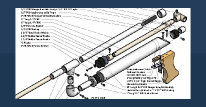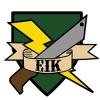First of all, many thanks go to Ben Trettel (Doom), who got me interested in air guns, and who, along with roboman, provided most of the purchasing information.
In the NIC, air guns do not receive nearly as much attention as springers do. This is possibly because people do not understand how they work. I did not understand how the different designs worked until I started researching it. In my quest, I have found many useful diagrams and articles that will help other people to understand how air guns work.
A basic understanding of valves is crucial to designing, building, or troubleshooting any air gun. Wikipedia defines a valve as "a device that regulates, directs or controls the flow of a fluid (gases, liquids, fluidized solids, or slurries) by opening, closing, or partially obstructing various passageways." Here are some excellent guides on valves.
Check Valves
One of the simplest valves is the check valve. It allows airflow only one way, therefore eliminating backflow in a system.
How one works
An extremely simple one built by Zorn's Lemma
Purchasing: PVC check valves are available from most hardware stores.  They are available in threaded and unthreaded. These are somewhat expensive, though, so McMaster's 7757K43 should do the trick. Check valves can also be acquired for free from Ark-Plas—see the Guides, Tips, and Tricks section of this post for more information.
They are available in threaded and unthreaded. These are somewhat expensive, though, so McMaster's 7757K43 should do the trick. Check valves can also be acquired for free from Ark-Plas—see the Guides, Tips, and Tricks section of this post for more information.
Over Pressure Valve
An over pressure valve, or pressure relief valve, is basically a check valve that vents after a certain pressure is reached. They are to be used with tanks to ensure that the maximum working pressure is not exceeded.
How one works
Homemade, adjustable, over pressure valve There is also a thread here that is about where to use them on air guns.
Purchasing: McMaster's 50265K23 works well and is the cheapest over pressure valve that I have seen.
Directional Control Valves
Directional control valves are used as pilot valves (basically the trigger) for exhausting air tanks. Here are explanations of their workings.
CaptainSlug's explanation of how three-way directional control valves work. This is an excellent guide to them. It is where I found out how they worked.
Animated explanation of two, three, and four-way directional control valves
Purchasing: McMaster's 6464K11 and Clippard's MJVO-3 MJVO-3 is much better than 6464K11. It has a higher flow rate, is smaller, cheaper, and can attach to trigger style buttons. The only reason to use the McMaster-Carr valve is if you can't buy Clippard valves.
Solenoid Valves
A solenoid valve is any valve that is controlled by electricity instead of manual input. For example, a solenoid directional control valve is a directional control valve that uses electricity instead of manual operation to switch the ports.
Quick Exhaust Valves
The Spudding Handbook gives an excellent definition complete with animated picture right here.
Ben Trettel posted an excellent article on a homemade that he built that utilizes a quick exhaust valve and a directional control valve. This was the article that got me into air guns.
Purchasing: McMaster's 6646K33 and 6646K11, and Clippard's JEV-F2M2. Both 6646K33 and JEV-F2M2 will work for Nerf guns. However, your power with JEV-F2M2 will be somewhat limited. Doom has not yet tried 6646K33, but he suspects that like the larger McMaster-Carr valve (6646K11), it is overkill. Either is fine depending on a project's goals. If you want power, go with 6646K33 or the even larger one. Here is the data sheet of McMaster-Carr QEVs. Ebay is also an excellent source for QEVs, and you can usually find a 1/2" one in the range of $10 or so.
Piston Valves
Piston valves, also known as back-pressure valves and back-pressure tanks, are the valves that are most often used in factory-made dart blasters. They are a type of quick exhaust valves that differ in form but not function.
The Spudding Handbook once again has the best diagram for piston valves here.(Be sure to click the play button under "Phase 0" to start the animation.) You can learn almost unlimited amounts of information about pneumatics by hanging around Spudfiles.
There are also several good articles on NerfHaven pertaining to piston valves.
The Nerf Secret Strike Internals This contains excellent PowerPoint drawings of how the internals work.
The Autopsy Pictures Thread This contains images of many cut-open pistons from factory-made dart blasters.
Now that you understand piston valves, let us move on to some examples. Buffdaddy has created multiple valves, with varying levels of success, such as Adventures in Air Guns, and the B.U.F.F.
Pneumatic Cylinders
Pneumatic cylinders, often called air cylinders, extend and retract under pressure. These are usually used for breeches when used in homemades. Some examples being FANG 1, and Abp5k. The Abp5k also uses a homemade directional control valve. Reading that entire thread will gain you vast amounts of knowledge about air guns, valves, regulators, and high pressure tanks.
How they work
Pressure Regulators
Pressure regulators regulate the pressure from a high-pressure source to a lower-pressure destination while keeping the pressure constant.
How they work
Another guide to how they work This one has an animated explanation of one and two-stage regulators.
Purchasing: Clippard's MAR-1NR is an adjustable, non-relieving pressure regulator that has been tested and works well. Harbor Freight has flow (not pressure) regulators around five dollars. Two examples are this and this. These Harbor Freight regulators are what is called "flow regulators" and are little more than ball valves. They are used to reduce flow rate, not pressure, so be advised.
Air Tanks
Quite a few air-gun designs utilize a larger, usually higher-pressure tank that charges a smaller tank that fires the blaster. Depending on size and personal preference, a designer will choose to integrate one with the blaster or to carry it on his back.
External air tanks are also often used with factory-made Nerf blasters to remove the necessity of pumping it up manually.
Paintball Tanks with Nerf
DIY: External Air Tanks
People have had an obsession with modifying Magstrikes to take external air tanks for years. CaptainSlug did the first here, and two other notable examples are this and this.
I mentioned this air gun before, but it is relevant here also. Ben Trettel's air gun here uses an integrated hard tank, as do FANG 2, and Pepé.
Purchasing: These tanks are absolutely fantastic. They have a working pressure rating to 125 psi, with a burst rating to 500 psi, and they're polyethylene, so they are pretty light. The brackets you can buy with them are awesome also, because they have a bolt hole already in them, and the tanks just snap in.
Guides, Tips, and Tricks
Buying Clippard Components
You can request a catalog from Clippard. They'll send you a very nice glossy printed catalog. This catalog contains all their products and a lot of technical data.
NPT dimensions This will give you the real (not nominal) dimensions of the National Pipe Thread Taper.
You can receive samples of many Ark-Plas products such as valves and polyurethane tubing for free. Use the sample request form that is under the item. An example is check valves. The sample request button is under each item that it is available for.
Harbor Freight and hardware stores such as Lowes and Home Depot carry many pneumatic items such as brass barbed fittings.
This is a guide on how to use latex tubing for air bladders.
Converting Flow Rates
Further Reading and Must-Read Articles
If you are interested in air guns, there are many interesting articles for you.
Homemade Magstrike Piston and Write-up
JSPB-The Mad Ghost This is a very simple air gun with an extensive write-up. Oh, and it is by 3DBBQ, who is one of the greats. You should read it. This explains how the triggers on his air guns work.
WNTS This is very similar to the 3DBBQ trigger system. It uses American parts though, so it may be helpful to you.
Dchap-1 This stands for "Dirt-cheap homemade air-powered," and it describes it exactly. It is simple and cheap.
Dchap-2 The second dirt-cheap homemade design.
Introduction to Pneumatics and Pneumatic Circuit Problems
S.C.U.N.B.A.G. This is a simple design with an in-depth write-up.
Semi-Automatic Valve
If you find any mistakes or would like me to add anything, send me a personal message.
Edited by DartSlinger, 06 March 2019 - 09:33 PM.






















